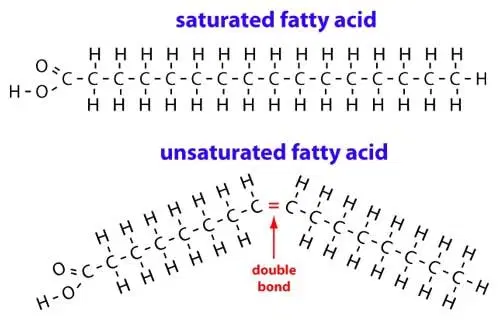Fats are composed of a three fatty acids attached to a glycerol backbone and are commonly referred to as triglycerides. Fatty acids are composed of a carbon chain to which hydrogen atoms are attached and they are fully saturated when carbon chain contains the maximum amount of hydrogen. Carbon atoms have 4 bonds which requires 2 of those bonds to link to other carbon atoms in the chain and leave 2 bonds available to bond with hydrogen. A mono-unsaturated fatty acid contains a single carbon double bond, which means that it is two hydrogen atoms short of being saturated. A poly-unsaturated fatty acid contains two or more carbon double bonds, which mean that it is then 4, 6, 8, etc hydrogen atoms short of being saturated. Dietary saturated fat generally has an even number of carbon atoms although there as trace amounts amounts of C15 and C17 facty acids found naturally in ruminant milk.
Since a mono-unsaturated fat contains a single carbon double bond, the fatty acid chain can have a "kink" in its shape due the missing pair of hydrogen atoms and this is known as the "cis" configuration. Hydrogen may be added to a poly-unsaturated fatty acid and if the hydrogen atoms are attached so that kink straightens out, the fatty acid with then have a "trans" configuration. Trans-fats do not occur naturally in foods in significant amounts but are much more common in hydrogenated vegetable oils (like shortening). Trans-fats adversely affect the metabolism and are implicated in insulin resistance and cardiovascular disease.
There are four groups of fatty acids characterized by carbon chain length. Ben Bikman has a series of Facebook videos that explain how fatty acids are metabolized.
- short chain fatty acids (SCFA), C1 - C5
- medium chain fatty acids (MCFA), C6 - C12
- long chain fatty acids (LCFA), C13 - C21
- very long chain fatty acids (VLCFA), C22+
Short chain fatty acids are generally produced by microbes, either through fermentation of dietary fibre in the gut or through food fermentation. Examples of foods containing SCFA are apple cider vinegar, sauerkraut, kimchi, kafir, yoghurt, and kombucha. The SCFA have somewhat of an unpleasant taste and are why fermented foods have a tart flavour. SCFA are primarily absorbed through the portal vein during lipid digestion and are burned the quickest by mitochondria and the body has no capacity to store them. SCFA aid in mitochondrial biogenesis and Butyric Acid (C4) is particularly useful metabolically as it helps to regulate the levels of metabolites associated with obesity. SCFA act as an appetite suppressant and lower the insulin response to a meal. Butyric acid (butyrate) is readily converted to the ketone body β-hydroxybutyrate (beta-hydroxybutyrate, BHB) and an important nutrition source for coloncytes (intestinal epithelial cells). Acetate (C2) and propionate (C3) also help nourish the gut and acetate may also be converted to the ketone body acetoacetate (AcAc).
Medium chain fatty acids are relatively tasteless and are commonly found in ruminant milk. Caproic acid (C6), Caprylic acid (C8), Capric acid (C10) are derived from the Latin word for goat: capra, which explain why goat milk is more tart than cow milk. Another excellent natural source of MCFA is cococnut oil. MCFA are increasingly ketogenic as the carbon chain become shorter, that is C6 is sgnificantly more ketogenic than C12 and C8 & C10 fatty acids are commonly used in ketogenic MCT (Medium Chain Triglyceride) supplements. C6 fatty acid is found in very small amounts (<1%) in coconut oil and is usually not included in MCT supplements. C8 generates a plasma ketone response (AcAc & BHB) that is 3X higher than C10 and C10 produces ketone response that is 2X higher than C12. MCFA consumption results in a higher metabolic rate than LCFA and MCFA has no effect on serum cholesterol levels. Lauric Acid (C12), the MCFA that gives coconut oil its solidity, has antimicrobial properties.
Long chain fatty acids are found in the bulk of a natural whole food diet. and commonly found in animal and fruit fats (eg, beef tallow, cocoa butter, shea butter). When LCFA are digested, they enter lymphatic capillaries once they are absorbed into chylomicrons and are then transferred to the blood at the subclavian vein.
VLCFAs are generally found in trace amounts in whole foods and are too long to be metabolized in the mitochondria, and must be metabolized via beta-oxidation in peroxisome.
Short and medium chain fatty acids are metabolized immediately (in the priority of their chain lengths?) and prior to glycose and glycogen because they are readily converted to ketones. Alcohol metabolism takes precedence all other fuels including ketones. Depending upon the body's metabolic state, LCFA will either go to the liver in the fasted state or to adipose tissue in the fed state. Once the body returns the fasted state and its glycogen stores are depleted, triglycerides (glycerol and free fatty acids) will be withdrawn from adipose tissue. If the Citric Acid (Krebs) Cycle is overwhelmed, the liver will start converting triglycerides to ketones and this allows excess fat to be wasted by the body either to thermogenesis by brown adipose tissue to wasted through respiration or urination.
See Metabolic Health
DISCLAIMER: My background is engineering and what I have written here is from my personal interest in staying healthy. If you disagree with any of it, let know what you feel is inaccurate and include some references so I can make corrections. This is a work in progress so check back often for updates as I continue to learn. CONSULT WITH YOUR DOCTOR BEFORE MAKING DIET AND LIFESTYLE CHANGES.

